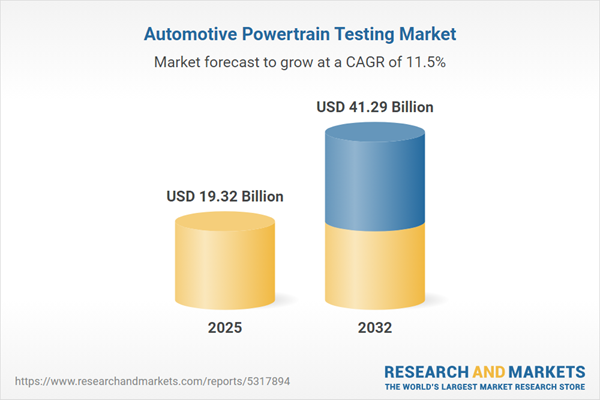Speak directly to the analyst to clarify any post sales queries you may have.
Automotive organizations worldwide are recalibrating their strategies to address rapid advances in mobility, sustainability, and regulatory requirements. As the automotive powertrain testing market becomes pivotal to robust product development, senior decision-makers are leveraging innovation and compliance to sustain competitiveness across regions.
Market Snapshot: Automotive Powertrain Testing Market Outlook
The automotive powertrain testing market is valued at USD 17.33 billion in 2024 and is projected to reach USD 41.29 billion by 2032, reflecting a compound annual growth rate (CAGR) of 11.46%. Investments in electric and hybrid vehicle testing infrastructure are accelerating as evolving regulatory standards demand advanced validation protocols. Manufacturers and service providers are enhancing their test systems to facilitate ongoing innovation, meet customer needs, and ensure compliance in a shifting global landscape.
Scope & Segmentation of the Automotive Powertrain Testing Market
This report enables executives to make strategic decisions by clarifying the key areas shaping powertrain testing transformation. The segmentation framework supports targeted operational investments and technology adoption:
- Powertrain Types: Battery electric, fuel cell, plug-in hybrid, diesel, gasoline, and CNG powertrains, each with unique testing demands supporting decarbonization and emission reduction goals.
- Vehicle Types: Heavy-duty commercial, light-duty commercial, and passenger vehicles, representing diverse compliance scenarios and influencing test and validation methodologies.
- Equipment Types: Data acquisition systems, chassis dynamometers, engine dynamometers, emissions analyzers, environmental test chambers, and integrated test cells, forming the technology stack for efficient throughput of new models.
- Test Types: Battery charging validation, durability trials, cycle runs, emissions measurement, performance analytics, thermal management evaluation, and cold-start assessments, ensuring safety and regulatory adherence.
- End Users: Original equipment manufacturers (OEMs) and independent laboratories, both focusing on modernization, efficiency, and compliance with evolving standards.
- Regional Coverage: Americas, Europe, Middle East, Africa, and Asia-Pacific, reflecting differentiated market strategies, regulatory trends, and investment priorities.
- Company Coverage: Profiles of AVL List GmbH, FEV Group GmbH, IAV GmbH, Horiba Ltd., MTS Systems Corporation, MAHLE GmbH, Schenck RoTec GmbH, Applus IDIADA, Ricardo plc, and Kistler Instrumente AG, with detailed insights into their compliance strategies and technology leadership.
Key Takeaways for Senior Decision-Makers
- Testing workflows must evolve quickly as propulsion technologies and compliance standards change, reinforcing the need for organizational agility and risk management.
- Simulation tools and predictive analytics help identify and mitigate compliance risks early in the R&D cycle, streamlining certification processes and enabling rapid adaptation.
- Improvements in calibration solutions and emissions measurement systems enhance accuracy in meeting stricter thresholds, particularly in priority regions.
- Flexible, modular test facilities support cross-functional collaboration and the prompt adoption of new propulsion systems, including electrified models.
- Adaptable laboratory management solutions empower teams to respond to regulatory shifts while maintaining innovation momentum and throughput targets.
- Regional market emphasis varies: Asia-Pacific focuses on battery validation, Europe prioritizes robust compliance strategies, and the Americas seek flexibility to address diverse powertrain technologies.
Impact of 2025 United States Tariffs
Forthcoming U.S. tariffs are compelling automotive powertrain testing stakeholders to reassess supply chain vulnerabilities and reinforce operational resilience. By investing in modular regional test hubs and localized calibration facilities, industry leaders are minimizing disruption risks, enhancing quality assurance, and maintaining continuous service delivery amid regulatory uncertainty.
Methodology & Data Sources
This analysis is underpinned by direct executive interviews, laboratory visits, and consultations with industry suppliers and compliance professionals. Comprehensive secondary research supports these findings, ensuring recommendations are aligned with automotive sector needs and decision-maker expectations.
Why This Report Matters for the Automotive Powertrain Testing Market
- Clarifies technology trends, regulatory drivers, and investment priorities needed for reliable planning and prioritization within the evolving automotive landscape.
- Provides frameworks for integrating innovative powertrain testing solutions, applicable across all automotive segments and global markets.
- Enables organizations to enhance operational performance, adapt to rapid change, and manage risk as sector complexity intensifies.
Conclusion
Success in the automotive powertrain testing market relies on continuous adaptation, technology integration, and collaboration across the value chain. Forward-thinking leadership and proactive adoption of advanced solutions will sustain competitive advantage as industry demands evolve.
Additional Product Information:
- Purchase of this report includes 1 year online access with quarterly updates.
- This report can be updated on request. Please contact our Customer Experience team using the Ask a Question widget on our website.
Table of Contents
3. Executive Summary
4. Market Overview
7. Cumulative Impact of Artificial Intelligence 2025
List of Figures
Companies Mentioned
The companies profiled in this Automotive Powertrain Testing market report include:- AVL List GmbH
- FEV Group GmbH
- IAV GmbH
- Horiba Ltd.
- MTS Systems Corporation
- MAHLE GmbH
- Schenck RoTec GmbH
- Applus IDIADA, S.A.
- Ricardo PLC
- Kistler Instrumente AG
Table Information
| Report Attribute | Details |
|---|---|
| No. of Pages | 189 |
| Published | November 2025 |
| Forecast Period | 2025 - 2032 |
| Estimated Market Value ( USD | $ 19.32 Billion |
| Forecasted Market Value ( USD | $ 41.29 Billion |
| Compound Annual Growth Rate | 11.4% |
| Regions Covered | Global |
| No. of Companies Mentioned | 11 |









